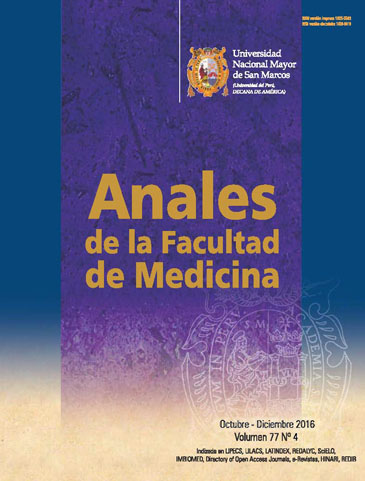In vitro physicochemical properties and antioxidant capacity of the aqueous extract of Gentianella nitida
DOI:
https://doi.org/10.15381/anales.v77i4.12648Keywords:
Gentianella, Antioxidants, Phenols, Flavonoids.Abstract
Introduction. The Gentianella nitida (hercampuri) is used as a hepatoprotective agent in traditional medicine. Objective. To determine the in vitro physiochemical properties and antioxidant capacity of the aqueous extract of Gentianella nitida. Design. Observational, analytical study. Setting. Biochemistry and Nutrition Research Center, Faculty of Medicine, Universidad Nacional Mayor de San Marcos, Lima, Peru. Material. 4% (w/v) of aqueous extract of the whole plant of Gentianella nitida from Junin. Interventions. Observation and analysis of the in vitro physicochemical properties and antioxidant capacity. Main outcome measures. Physicochemical properties (apparent density and soluble matter); antioxidant capacity using DPPH, ABTS and FRAP; total phenols content and flavonoids. Results. The Gentianella nitida presented an apparent density of 1,032 g/mL. With the DPPH and ABTS methods it had IC50=145 ug/mL and 1.49 ug/mL respectively; the antioxidant capacity equivalent to the ascorbic acid (AAEAC-DPPH) was 56 (ug AA/mg ss) and the antioxidant capacity equivalent to the trolox (TEAC-ABTS) was 87.7 (μg trolox/mg ss). Expressed in Frap, these were 98.5 (μg FeSO4/mg ss) and 55.6 (μgEAA/mg ss). The total phenolic content was 65.8 ug EAG/mg soluble solid and flavonoids was 11.7 ug EQ/mg soluble solid. Conclusions. The aqueous extract of Gentianella nitida exhibited antioxidant capacity that correlated with the content of phenolic compounds.Downloads
Published
2016-12-16
Issue
Section
Artículo Original
License
Copyright (c) 2016 Kelly Nora Carbonel Villanueva

This work is licensed under a Creative Commons Attribution-NonCommercial-ShareAlike 4.0 International License.
Those authors who have publications with this magazine accept the following terms:
- Authors will retain their copyrights and guarantee the journal the right of first publication of their work, which will be simultaneously subject to Creative Commons Attribution License that allows third parties to share the work as long as its author and its first publication this magazine are indicated.
- Authors may adopt other non-exclusive licensing agreements for the distribution of the version of the published work (eg, deposit it in an institutional electronic file or publish it in a monographic volume) provided that the initial publication in this magazine is indicated.
- Authors are allowed and recommended to disseminate their work over the Internet (eg: in institutional telematic archives or on their website) before and during the submission process, which It can produce interesting exchanges and increase quotes from the published work. (See El efecto del acceso abierto ).
How to Cite
1.
Carbonel Villanueva KN, Suárez Cunza S, Arnao Salas AI. In vitro physicochemical properties and antioxidant capacity of the aqueous extract of Gentianella nitida. An Fac med [Internet]. 2016 Dec. 16 [cited 2025 Jun. 7];77(4):333-7. Available from: https://revistasinvestigacion.unmsm.edu.pe/index.php/anales/article/view/12648



